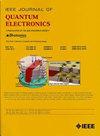Performance Dependence of Optical-Loop-Based Coherent Ising Machine on Operating Conditions
IF 2.1
3区 工程技术
Q3 ENGINEERING, ELECTRICAL & ELECTRONIC
引用次数: 0
Abstract
Coherent Ising machines (CIMs) are optical computers designed to solve combinatorial optimization problems based on the Ising model. Among several variants, the optical-loop-based CIM, which utilizes optical pulses with binary phases circulating in a loop equipped with a pulse-pumped phase-sensitive amplifier (PSA) and a measurement feedback circuit, has experimentally demonstrated high performance in terms of the number of pulses and connectivity. This study numerically investigates the dependence of its calculation performance on operating conditions such as the noise level, coupling strength between pulses, and PSA pump increment rate. The CIM solving Max-Cut problems is simulated using a difference equation based on a traveling-wave model under various operating conditions. The results indicate that noise is not a critical factor, there is an optimal condition for the coupling strength, depending on the graph structure, and slower pump-increment rate leads to higher scores. Under optimal conditions, the simulation produces better calculation results than those previously reported in an experimental study.基于光环路的相干Ising机性能对工作条件的依赖性
相干伊辛机(CIMs)是一种基于伊辛模型解决组合优化问题的光学计算机。在几种变体中,基于光环的CIM利用具有二进制相位的光脉冲在配有脉冲泵浦相敏放大器(PSA)和测量反馈电路的环路中循环,实验证明了在脉冲数量和连通性方面的高性能。本文从数值上考察了其计算性能与噪声水平、脉冲耦合强度和PSA泵增量率等工况的关系。采用基于行波模型的差分方程对CIM在不同工况下求解最大切割问题进行了仿真。结果表明,噪声不是关键因素,耦合强度存在一个最优条件,取决于图的结构,泵浦增量率越低得分越高。在最优条件下,仿真计算结果优于已有的实验研究结果。
本文章由计算机程序翻译,如有差异,请以英文原文为准。
求助全文
约1分钟内获得全文
求助全文
来源期刊

IEEE Journal of Quantum Electronics
工程技术-工程:电子与电气
CiteScore
4.70
自引率
4.00%
发文量
99
审稿时长
3.0 months
期刊介绍:
The IEEE Journal of Quantum Electronics is dedicated to the publication of manuscripts reporting novel experimental or theoretical results in the broad field of the science and technology of quantum electronics. The Journal comprises original contributions, both regular papers and letters, describing significant advances in the understanding of quantum electronics phenomena or the demonstration of new devices, systems, or applications. Manuscripts reporting new developments in systems and applications must emphasize quantum electronics principles or devices. The scope of JQE encompasses the generation, propagation, detection, and application of coherent electromagnetic radiation having wavelengths below one millimeter (i.e., in the submillimeter, infrared, visible, ultraviolet, etc., regions). Whether the focus of a manuscript is a quantum-electronic device or phenomenon, the critical factor in the editorial review of a manuscript is the potential impact of the results presented on continuing research in the field or on advancing the technological base of quantum electronics.
 求助内容:
求助内容: 应助结果提醒方式:
应助结果提醒方式:


